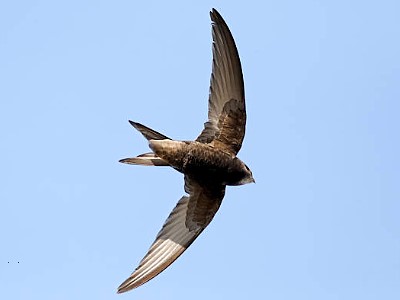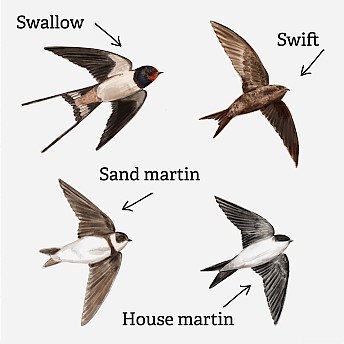 Swifts: Masters of the air
Swifts: Masters of the air
It is time to watch out for those black, scimitar-shaped birds that grace our skies for a few brief months each summer.
They are Common Swifts (Apus apus), a migrant species that visits us each year to breed, arriving in Thames Ditton suddenly in late April and leaving equally abruptly for Southern Africa at the end of August.
Swifts are often confused with Swallows and House Martins, but although they are superficially similar, they are not closely related and have very different life strategies. Swifts have long curved wings whereas those of Swallows and House Martins are more swept back. Swifts are sky-dwellers, spending the vast majority of their days and nights on the wing. They feed on invertebrates, usually at quite high altitude and may travel considerable distances every day to find food or avoid inclement weather.
 Historically Swifts would have bred in crevices in cliffs and trees. These days they are almost entirely dependent on small holes in buildings. They visit their nest sites relatively infrequently and enter them at speed, so many home owners are oblivious to their presence. But Swifts are long lived birds and it is thought some nest holes have been used for decades.
Historically Swifts would have bred in crevices in cliffs and trees. These days they are almost entirely dependent on small holes in buildings. They visit their nest sites relatively infrequently and enter them at speed, so many home owners are oblivious to their presence. But Swifts are long lived birds and it is thought some nest holes have been used for decades.
Swifts were recently added to the Birds of Conservation Concern Red List, with the UK population thought to have declined by around 65% since 2000. The precise reasons for this decline are unclear, but it is likely to be a combination of factors including a lack of invertebrate prey and the loss of nesting sites.
Building modifications such as loft conversions along with modern construction methods mean that many nest sites have been lost. Scaffolding erected in the breeding season can inadvertently block nest access. For some reason Swifts struggle to exploit new nesting opportunities and once the nest is lost they may move on permanently. They will use nest boxes, particularly where these are close to existing colonies, but their adoption can take a few years.
It is unclear how many active Swift nests there are in Thames Ditton and we want to know. There is certainly a population, maybe 10-20 pairs, in an area centred on Alexandra, Queens and Summer roads. Low-flying groups of screaming Swifts are a strong indication of local breeding and this behaviour is witnessed almost daily in this area of the village in the early summer.
But are there more colonies we don’t know about? We are keen to get a feel for where there are Swift nesting sites in Thames Ditton and Weston Green. We hope that by establishing where they are, we can try to protect nest sites when building or improvement work is planned. Depending on interest from residents, we might also consider whether to establish nest boxes to help strengthen the local population.
A number of community Swift Action Groups have been formed around the country and they have clearly demonstrated that population decline can be reversed through vigilance and nest box provision. We could do the same here.
At this early stage we are keen to gauge local interest in Swifts and are asking residents to keep an eye out for two things:
- Groups of low fast flying swifts (usually screaming!) anywhere beyond the Alexandra/Queens/Summer Roads known population.
- Swifts seen entering nest holes anywhere in the area.
If you want to join in the TD&WGRA Swift Survey, please send details of your sightings to Gill Coates at gcoates@residents-association.com and we will come and check them out. And if you are already monitoring Swifts or interested in joining this project, let us know.
